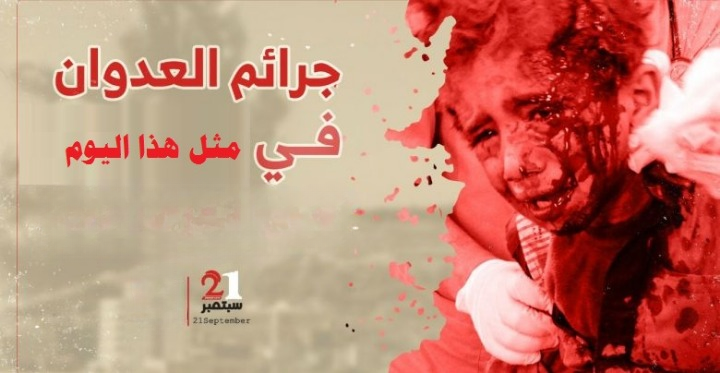November 12: A Day Etched in Yemen’s Wounds and a Chronicle of U.S.–Saudi–UAE Aggression
Each year, November 12 returns as a painful reminder for Yemenis — a date that revives the chapters of bloodshed, destruction, and anguish left behind by the U.S.–Saudi–UAE aggression against the land and its people.
It stands as evidence that the wounds remain open and that the Yemeni memory does not forget. On this date across multiple years of war, systematic massacres and attacks struck villages, cities, farms, ports, schools, and homes — in flagrant violation of all humanitarian and international laws.
2015: The Beginning of Fire – The Blood of Kitaf and Saada
On November 12, 2015, Saudi forces rained artillery shells on the areas of Al-Malil, Al-Buqa’, and Al-Suh in the Kitaf District of Saada, firing more than seventy shells that caused widespread destruction to homes and farms.
In Hajjah Province, coalition warplanes carried out ten separate airstrikes targeting the districts of Midi, Harad, Hairan, and Abs, inflicting heavy damage on public and private property.
2016: Cluster Bombs Hit the Capital and Hodeidah
In 2016, coalition warplanes committed new massacres by bombing the Al-Jah area in Beit al-Faqih District, Hodeidah, killing three civilians and injuring two others.
Airstrikes also hit the Naval Academy, Ras Isa, Al-Khokha, and Al-Salif.
In Sana’a, cluster bombs were dropped on Jabal Umm al-Rukab and Jabal al-Akhdar in Nihm District, while other strikes targeted Bani Matar and Bani Hushaysh, destroying homes and farmlands.
Attacks also extended to Mokha, Dhubab, Taiz, Saada, Lahj, and Marib — part of a brutal campaign that left a trail of devastation.
2017: Relentless Strikes and Border Shelling
On November 12, 2017, the killing machine did not pause. Coalition aircraft bombed the Sirwah District in Marib, while mercenaries shelled residential areas in the same district.
Saudi artillery targeted civilian farms in the border districts of Ghamr and Haydan in Saada.
Five airstrikes hit the village of Qamar in Jizan, one struck the city of Al-Rabu’ah in Asir, and several more targeted Nihm, Hajjah, and other provinces.
2018: Hodeidah Under Fire – Port and University Targeted
In November 2018, the focus shifted to Hodeidah, where coalition warplanes struck the Hodeidah Port, the University of Hodeidah, and an area near the airport.
A residential house in the Al-Ghalil neighborhood of Al-Hawk District was also bombed.
Four civilians, including a child, were injured when coalition Apache helicopters opened fire along the main road in Baqim District, Saada.
2019: A Wounded Child in Saada and Destruction in Al-Tuhaita
On November 12, 2019, a young girl was injured by Saudi gunfire in a border village in Razeh District, Saada.
Coalition aircraft bombed the Takhyah area in Majz District, while mercenaries shelled the farm of a local resident in Al-Tuhaita District, Hodeidah.
2020: Escalation in Marib and Al-Jawf
The year 2020 witnessed intensified airstrikes — six on Majzar District, three on Wadi Habab in Sirwah, five on Madghal in Marib, four on Al-Dhahra in Khab and Al-Sha’af, two on Bart Al-Anan in Al-Jawf, and three on Al-Ajasher near Najran.
Numerous areas in Hodeidah were also heavily bombarded with artillery fire from coalition-backed forces.
2021: Children of Al-Tuhaita Killed Beneath the Rubble
On November 12, 2021, coalition aircraft carried out a horrific attack in Al-Tuhaita District, Hodeidah, killing four civilians, including three children, and injuring two others.
Spy drones launched six more strikes on Hays, Al-Fazah, and Al-Jah areas.
In Saada, one civilian and four African migrants were wounded by Saudi shelling on Al-Raqw in Munabbih District, while airstrikes continued on Al-Dhaher, Marib, Taiz, and Hajjah.
2022: Renewed Fortifications in Hodeidah
On November 12, 2022, coalition-aligned mercenaries built new combat fortifications in the Al-Jabaliya area of Al-Tuhaita and resumed artillery and gunfire attacks across Hodeidah, in a clear violation of the ceasefire agreement and a continuation of the coalition’s attrition policy against civilians.
An Unfading Memory, a Testament to Unbroken Resilience
These recurring atrocities on the same date each year reveal that the U.S.–Saudi–UAE aggression was not a transient episode, but a sustained campaign of destruction targeting Yemen’s people, livelihoods, and stability.
With every new crime, the Yemeni people renew their vow of steadfastness and resistance.
The blood shed across every village and city will not be forgotten — it remains a permanent testament to both the brutality of the aggressors and the unyielding courage of a nation that refuses to bow.

